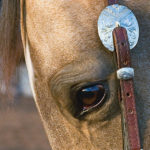Question:
We tend to travel for horse trail rides in remote areas. In the event that we need emergency veterinary care while on the trail, it’s not always easy to find. Do you know of a website that we can search for equine vets in the area that we travel? Any help would be appreciated. – David Rogers, Hockley, Texas

Answer:
That’s a very good question, David. First, to specifically answer your question about an online site, I’d recommend that you visit www.aaep.com, hosted by the American Association of Equine Practitioners. The AAEP has members all over the United States (and the world, for that matter) who have a special interest in horses and their care. That doesn’t mean that an equine practitioner who may not belong to the AAEP isn’t a good choice, so check around. Here are several things you can do to find a good vet when you’re traveling with your horse.
Find a Vet
Before you leave home, map out your trip. Make a list of metropolitan areas, as well as the smaller towns along your route and close to the places you plan to stop. Take that list to your regular veterinarian’s office, and ask for names and phone numbers of vets in those areas.
Your vet will likely refer to the American Veterinary Medical Association directory. You may wish to borrow the directory and make the list yourself. Take that list, and telephone the clinics to find out their hours of operation, location, and how to get help in case of an emergency.
In the event you arrive at your destination without doing the above, you can do several things that may provide you contact information.
? Go to the local feed store and ask for a recommendation.
? Ask the local farrier for his or her recommendation.
? Look in the Yellow Pages.
When you find a vet in the area you’ll be traveling, call the clinic. Tell the vet or staff member that you’ll be in the area for a few days and would like to make sure you can get help if needed. Once you’re on the road, you can even stop by the local veterinary clinic, introduce yourself, and pick up a card.
To find a vet while on the road, you can also stop in the district office of the land-management entity you’re visiting, and ask to speak to an employee who has horses. You can ask him or her about local vets – and find out the best places to ride. Also ask around at the horse camp you’re staying in.
Emergency Prep
Of course, it’s best to avoid a disaster in the first place by keeping emergency supplies on hand. For specific recommendations on compiling a first-aid kit, see the very good article by my friend Nancy Loving, DVM, that appeared in the January/February ’05 issue of The Trail Rider. Take out the article, and read it again. Ask your vet to help you put together items mentioned, and take them along on every ride.
There are small, inexpensive items you should carry in your saddlebags that will make the emergency controllable and could even save a life.
Here’s a partial list for you to use as a start; trail talk with others to expand your preparedness.
? Vetrap or other bandaging material will give you something to help control bleeding, support an injury, or even to fashion a splint.
? Roll gauze makes bandaging a laceration more effective and also helps with hemorrhage control.
? Gauze pads help control bleeding and protect wounds.
? Eye ointment protects eyes.
? A hemostat (locking clamp) helps control hemorrhage; you can also use this tool to remove thorns or cactus spines. (Ask your vet to get you one.)
? Sewing thread can be used as a ligature when you have a major blood vessel bleeding.
? Antibiotic ointment is recommended for wounds.
? A hoof pick and a temporary horse shoe (such as an Easyboot) help manage hoof problems.
? A sharp, sturdy pocketknife with a serrated blade lets you quickly remove tack in an emergency.
The most common trail injury seems to be a laceration; an emergency arises when the bleeding is hard to control. If the bleeding is a pumping hemorrhage, then most likely you’ll need to find the artery, pinch it off with a hemostat, and tie a knot around it. Sometimes, a pressure bandage will stop the bleeding, but it should remain in place only a few hours to avoid pressure-related damage. You can usually stop venous (vein-involved) bleeding with simple pressure bandaging. Get the bleeding under control, and get your horse to a veterinarian for professional help.
Eye injuries can certainly constitute an emergency. Clean the eye with fresh water, and apply eye ointment. An eye bandage will help reduce light-related pain. Always have a vet examine any eye injury to determine whether it involves the very delicate cornea; corneal abrasions need special care.





